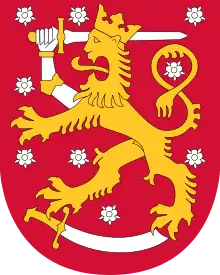1966 Finnish parliamentary election
Parliamentary elections were held in Finland on 20 and 21 March 1966.[1] The Social Democratic Party (SDP) overtook the Centre Party as the largest faction in Parliament. Rafael Paasio of the SDP subsequently became Prime Minister and formed a popular front government consisting of the SDP, the Centre Party, the People's Democratic League (SKDL), and the Social Democratic Union of Workers and Smallholders (TPSL) in May 1966.[2][3]
 |
|---|
| This article is part of a series on the politics and government of Finland |
|
|
Background
Prior to the elections, Centre Party Prime Minister Johannes Virolainen had led a centre-right coalition government since September 1964. Meanwhile, Paasio had moved the SDP further to the left in order to attract back voters from the TPSL. Finnish society was undergoing a period of radical criticism of traditional values, such as Christianity, marriage, parents' authority over their children, teachers' authority over their students, patriotism, and civil servants' (including judges') authority over private citizens. The Social Democrats and the SKDL tapped into this discontent at the expense of the centre-right coalition. At the same time, leading Social Democrats, such as former Minister of Social Affairs and Minister of the Interior Väinö Leskinen, had promised to support President Kekkonen's foreign policy with regards to the Soviet Union, and his continuance as President.
Results
Overall, the leftist coalition achieved a combined majority (51.0%) of the votes cast in the election.
| Party | Votes | % | Seats | +/– | |
|---|---|---|---|---|---|
| Social Democratic Party | 645,339 | 27.2 | 55 | +17 | |
| Centre Party | 503,047 | 21.2 | 49 | –4 | |
| Finnish People's Democratic League | 502,374 | 21.1 | 41 | –6 | |
| National Coalition Party | 326,928 | 13.8 | 26 | –6 | |
| Liberal People's Party | 153,259 | 6.5 | 9 | –5 | |
| Swedish People's Party | 134,832 | 5.7 | 11 | –2 | |
| Social Democratic Union of Workers and Smallholders | 61,274 | 2.6 | 7 | +5 | |
| Smallholders' Party | 24,351 | 1.0 | 1 | +1 | |
| Finnish Christian League | 10,646 | 0.4 | 0 | New | |
| Åland Coalition | 7,118 | 0.3 | 1 | 0 | |
| Independence Party | 513 | 0.0 | 0 | New | |
| Christian Women of Western Finland | 124 | 0.0 | 0 | New | |
| Christian-minded of Northern Savonia | 30 | 0.0 | 0 | New | |
| Others | 51 | 0.0 | 0 | – | |
| Write-in lists | 161 | 0.0 | 0 | – | |
| Invalid/blank votes | 8,537 | – | – | – | |
| Total | 2,378,583 | 100 | 200 | 0 | |
| Registered voters/turnout | 2,800,461 | 84.9 | – | – | |
| Source: Tilastokeskus 2004[4] | |||||
Popular vote
Seats in parliament
References
- Nohlen, D & Stöver, P (2010) Elections in Europe: A data handbook, p606 ISBN 978-3-8329-5609-7
- Seppo Zetterberg et al (2003) A Small Giant of the Finnish History, WSOY
- Allan Tiitta and Seppo Zetterberg (1992) Finland Through the Ages, Reader's Digest
- 595. Eduskuntavaalit 1927–2003 (Tilastokeskus 2004)